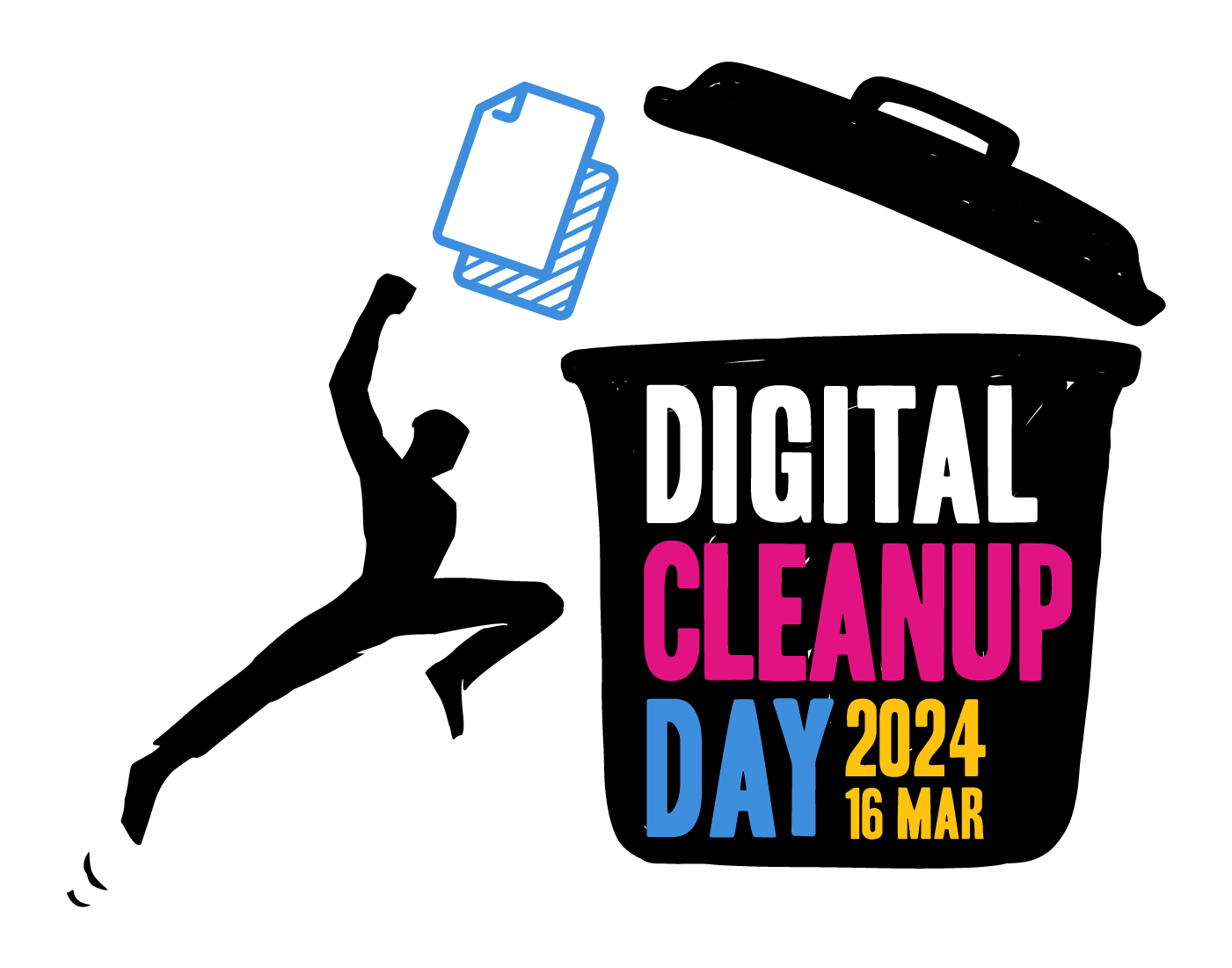90% of data sits unused. How to get rid and avoid digital waste
Research shows that 90% of stored data (photos, documents, emails, etc.) becomes unused after just three months. Digital waste isn't just a nuisance, but also impacts businesses significantly, both financially and in terms of productivity, not to mention energy wastage. We'll dissect why so much digital waste accumulates and how to get rid of it.
Katerina Chantzi, a Digital Waste Trainer with the NGO Let’s Do It World. Photo: Piret Räni
Digital Cleanup Day was held this year on 16 March. While World Cleanup Day involves collecting plastic bottles from beaches or car tyres from forests, Digital Cleanup Day aims to keep the online environment just as clean, where today we often spend even more time than in nature. For instance, Europeans spend on average 35% of their waking hours in front of screens, roughly six hours a day.
Every email received wastes 16 minutes of valuable time
"Digital waste includes all internet-created data that is no longer used or serves no purpose," explains Katerina Chantzi, a Digital Waste Trainer with the NGO Let’s Do It World. This could be outdated calendar invites, unnecessary document copies, excessive emails, etc.
It's likely everyone has noticed how tricky it is to find the right file or information amidst a seemingly endless pile of digital waste at the needed moment. From a company's perspective, this time wastage and inefficiency can be converted into money. Employees spend $1800 (approx. £1646) annually on unnecessary emails, plus $1250 (approx. £1143) on managing spam. "On average, an employee receives 304 emails a week, and it takes about 16 minutes to refocus after each email. Such distractions decrease productivity, creating stress and dissatisfaction," Chantzi explains.
Storing unnecessary information uses electricity
Dealing with digital waste isn't just about cleaning out inboxes; it requires reshaping the work, according to Chantzi. Data cleaning should be standard practice. "By optimising digital processes and reducing unnecessary data, companies can increase productivity, reduce operational costs and security risks," says Chantzi.
Moreover, getting rid of digital clutter also saves the environment, increasingly a focus today. "By reducing the volume of unnecessary data, companies can significantly lower their carbon footprint. For example, according to Cleanfox, the average internet user receives 2850 unwanted emails a year, resulting in 28.5 kg of CO2 emissions," Chantzi explains. Every email – like every other action on the internet – physically resides somewhere, using up server space, which in turn consumes electricity and burdens the environment.
Don't fall for greenwashing
So, what can be done to prevent digital waste? Chantzi suggests that companies focus on prevention by identifying and eliminating digital waste through smooth email management, efficient file organisation systems, and workflow practices. "Promoting a culture that values efficient data storage and environmental responsibility is crucial," she says.
****
Tallinn University of Technology's Head of HPC Center, Lauri Anton:
In the world of science and technology, especially in massive projects like CERN's Large Hadron Collider (LHC), data management and optimisation have become central issues. In the case of the LHC, detectors produce vast amounts of data, most of which is unnecessary and immediately discarded, keeping only a fraction of "interesting" results.
This approach of filtering data at the point of creation is a crucial step in reducing digital waste. This trick could also be used by people who, when taking pictures or videos with a smartphone, would only keep those video clips where something exciting happens or only those pictures that are of high quality.
Data optimisation isn't just a concern for large science projects. Every one of us produces digital trash daily, whether it's unnecessary emails, duplicate photos, or unused files. To tackle this challenge, it's important to understand how to store data more energy-efficiently and make informed choices to reduce their environmental impact.
One way is to reduce media formats. We often use pictures (e.g., memes) instead of text, and videos instead of pictures, which significantly increases data volume. If a message can be conveyed with text, replacing a voice message with a standard email could reduce data volume by tens of times. This is a simple yet effective way to limit data amounts. Likewise, it's worth remembering that "less is more" – shorter videos, fewer pictures in galleries, or simply writing shorter messages because no one really has the time to read long forum posts, letters, or other notifications anymore.
Another important aspect is the choice of storage media. The data density of hard drives is constantly increasing, without a corresponding increase in energy consumption. This means that the energy cost per unit of storage decreases over time. Therefore, investing in storage devices that are energy-efficient and whose capacity matches the need without a large surplus is also an important step towards a more environmentally friendly digital world. Simply put – it's not worth buying storage capacity with too much surplus; next year it might be available more cheaply.
Don't discount older technology, either. For instance, storing large amounts of data that are rarely used on magnetic tapes or saving pictures and videos on CD/DVD at home can be a sensible choice. The advantage of external storage devices that are not constantly in use is that their energy consumption is zero when not in use, which helps reduce overall energy costs.
In the digital age, optimising data and reducing waste has become crucial for sustainability and efficient resource use. By making informed choices in data management, we can all contribute to reducing digital waste and creating a more sustainable digital future.
****
Chantzi recommends that companies implement an email policy to limit unnecessary communication and bulky email signatures (e.g., adding image files, logos, etc., to the email footer). "In addition, every company should review its data storage practices and choose data centers with the lowest possible CO2 emissions to minimise environmental impact," she adds. It's important not to fall into the trap of greenwashing but to find a genuinely sustainable data management partner.
Data can be hosted energy-efficiently
According to Tõnu Grünberg, CEO of the Baltic's most energy-efficient data center, Greenergy Data Centers, it's inevitable that some businesses have large data volumes or require significant computing power. "In such cases, it's crucial to understand that storing and using data daily is directly linked to energy consumption, as servers, storage, and network equipment require electricity. The more data there is, the more organisations should consider where and with what ecological footprint their data is stored," he explains.
Take the opportunity to participate in Digital Cleanup Day. Photo: NGO Let’s Do It World
One of the simplest ways is to ask the service provider or measure in the office (server room) how much energy is directly used by IT devices and how much for cooling, security, and supporting services. "This provides a factual basis for comparing different service providers or technical solutions," Grünberg adds, "and it's also worth checking if the external service provider uses certified green energy."
Of course, the ecological footprint of a company's data also depends on the devices used. Newer devices are generally much more energy-efficient. This means that more work can be done with the same amount of power, thereby lowering the business's ecological footprint.
"The European Union is paying more and more attention to the energy efficiency of data storage, and various regulations have been developed that member states must incorporate into their legislation. In the coming years, we can expect major changes and stricter rules at the legal level. Fortunately, our data center was built with higher energy efficiency requirements in mind," Grünberg describes the future.
In summary, by prioritising data efficiency, every company can save costs, increase productivity, and reduce its environmental footprint. Adopting a culture of digital responsibility and efficiency is not only beneficial but essential for long-term success in an increasingly digital world.


